Suffolk Punch 17sk
Hi everyone I just got my first petrol lawnmower off of Freecycle. Figured i could have a go at fixing it.
First time working on an engine but been having a lot of fun.
When I first got it I could get it started but would cut out and then it wouldn't start again giving me a very sorry arm lol.
Have since cleaned the carburettor with carburettor cleaning spray and can now get it started with the first pull. It also doesn't cut out when moving the choke from fully open.
I have a couple of questions though. As soon as I start the engine the blades are spinning and I can't get them to stop. Not sure why that's happening. And also I seem to have a problem in that the self drive doesn't work at all.
I have tried adjusting the nut at the end of the cable but it is not biting. I have checked the belts and they seem to be tightening when I put the level but there is no drive.
Any help would be greatly appreciated.
Kind regards
Steven
Forums
Thanks very much for the
Thanks very much for the quick response :D
I had another go at it tonight. I took the belt cover off and spray some wd40 in about it. This made a belt start to move more and also made the roller move a lot better when free wheeling. Also when I lift the mower up off the ground with the lever pulled back the roller turns it just hasn't got enough to torque to pull the lawnmower. There is also a broken lever that I think is for engaging the cutting cylinder. When I pull the wire though it doesn't do anything.
I have lots of videos and pictures for you to look at and see what's going on.
https://photos.app.goo.gl/NZcDHaDw5KEjPgii1
Kind regards
Steven
I can’t view any of your
I can’t view any of your images as Google is asking for access to my photo library - why?
EDIT.
I was trying to view your images on the iPad which gave rise to that message. Now on the PC, all is revealed.
The right-hand handlebar lever controls the drive to the cutting cylinder but also requires the engagement of the red lever, called the cable grab, before it will do anything; until the red lever is engaged the main one remains "floppy". The action is, push and hold the red lever forward and lift the cutter engagement lever. Once the lever is lifted it is no longer necessary to hold the red lever forward.
The right hand, wide, lever should engage the roller drive regardless of whether or not the cutters are engaged. From what you are saying the lack of drive to the roller may just be belt slip but could also be due to a problem with the roller drive pinion. It may also be worth checking the coupling between the engine and the top shaft that drives both belts. The coupling lives under the cover to the left of the engine and they have been known to come loose.
<p>Oh sorry I'm not sure
<p>Oh sorry I'm not sure why. Here's the photos and some YouTube video links of my mower.</p>
<p> </p>
<p> </p>
Sorry I didn't uploads the
Sorry I didn't uploads the pictures. Hope you can see them.
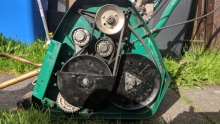
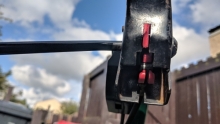
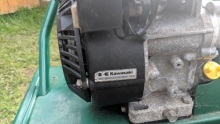

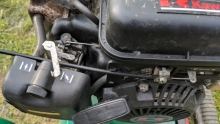
Kind regards
Steven
Our posts crossed !!
Our posts crossed !!
Haha so they did!
Haha so they did!
So the small lever with the broken cable grab is for the cutting cylinder? Do you think if I buy a new cable grab the cutting cylinder wil be able to be stopped?
I will take off the cover tomorrow and check the coupling too.
Do you think if I buy a new cable grab the cutting cylinder wil be able to be stopped?
NO, but did it break because of the cable or jockey pulley being partly seized and requiring more pull than than the plastic could stand; and being partly seized is holding it in drive. According to my old stock file the grab was part number F016L36717 and we also showed a Grab repair kit F016L37700. Not sure whether those numbers will still be valid. The grab was 89p but the kit £10+, so hopefully you just need the grab.
Thanks for the part numbers
Thanks for the part numbers that's a real help! I will have a go at tightening the coupling if it is loose today and let you know how I get on.
Kind regards
Steven

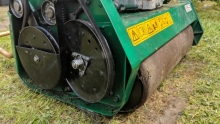
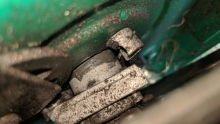 


Ok I think I've found a problem cracked bracket or something.
Right behind this pulley.
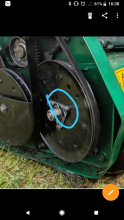
Is it the pulley boss that's
Is it the pulley boss that's cracked or the support bearing behind the pulley? If the latter, the drive pinion will be out of alignment with the roller.
There were a number of issues with early machines using that chassis but by the time that the Kawasaki engined machines came along, I would have expected all the mods to incorporate into production.
Some of the attached may be applicable - ignore the first page.
https://www.dropbox.com/s/aeehg9ssysh03xg/Suffolk%20Qualcast%20QX%20iss…
EDIT Just occurred to me, has your machine got a two-piece rear roller? If so it will have a differential in the centre and the bolt securing the diff to the shaft may have seized resulting in no drive or just partial drive when the sheared bolt grabbed the shaft.
I'm pretty sure it's the
I'm pretty sure it's the support bearing. I'll have a look at that pdf. Thank you very much for sending me that it's much appreciated. I take it I will have to take the engine off to get the roller off? I can see a big nut in the centre of the pulley that just turns when I try to loosen.
Kind regards
Steven
I'm not sure what you mean by
I'm not sure what you mean by a 2 piece roller. Just looks like one roller to me.
On second thoughts, I think
On second thoughts, I think that it’s only the twenty inch machines that have the two section roller to aid turning without smearing the turf.
Taking the engine off is not necessary but will make the machine easier to handle. The fact that the centre nut just rotates is, I think, a clue. If memory serves me correctly the nut is on the end of the pinion shaft and the shaft should engage with the pulley with two flats. The fact that the shaft is turning independently from the pulley suggests that either the flats in it or those on the pinion, are damaged enough to allow independent movement.
However before we go down the route of trying to get the nut off I need to check the my advice is in fact correct for your machine. Can you confirm that the centre of the pulley is off set from the apparent centre of the roller. A decent square on image image will help.
The pulley definitely seems
The pulley definitely seems higher and I bit to the left from where the roller sits which I though was a bit strange.
That confirms the layout is
That confirms the layout is as I thought . The pulley drives a pinion that engages with a ring gear on the inside of the roller so it is off set by approximately half the diameter of the roller. It is possible that the pinion will be reusable so whatever method is used to remove the nut should not damage the shaft.
If the pinion is still in engagement with the ring gear, holding the roller stationary while undoing the nut , should work. If holding the roller does not prevent the pinion from turning, plan B has to involve cutting the nut off without damaging the shaft - just in case it can be reused.
The nut turns when the roller
The nut turns when the roller is stationary.
Seem I will have to cut it off then? How would I go about that? Grinder with cutting disk do you think?
Kind regards
Steven
If I had to cut the nut off
If I had to cut the nut off in situ I would use a dremel type tool with correct type cutting wheel and very carefully at that. Then prise the nut and split it along the length of the cut with a sturdy flat blade screwdriver before you cut through to the threads on the shaft. If the nut is just spinning now I would image the thread on the shaft is damaged and would need re-threading.
Getting an angle grinder or power file in there looks tricky. I find it hard to see detail of pictures as they come up so small on my PC
X2 for the use of a Dremel
X2 for the use of a Dremel type tool. If you look at the attached images you will see the two flats on the shaft. If the pulley is not driving the shaft ( pinion on the other end) either the flats on the shaft or those in the pulley are rounded off - or possibly both!!
If you position your cut opposite a flat it allows a bit more wiggle room without damaging the ( hopefully) undamaged shaft.
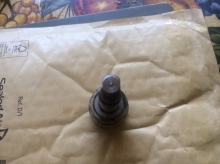
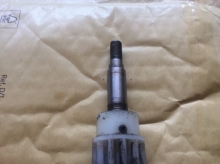
The nut highlighted with the white marker is the end of the "dead shaft" around which the roller rotates. To remove the roller you will have to undo this nut and the corresponding one under the plastic cover on the right hand side of the mower. That end of the shaft is in a slot allowing the roller to drop out.
Thanks for all your help guys
Thanks for all your help guys!
Do you think something like this would do the trick?
I have a dremmel so could easily have a go at this.
Kind regards
Steven
You really need the smallest
Sorry guys, just posted a fairly long alternative suggestion and the website gave an unexpected error message and dumped it.
will try again later when in better temper !!!!!!!
You really need the smallest
You really need the smallest Dremel disc that will do the job otherwise it will be cutting into the pulley boss before completing the cut in the nut.
Thinking about it, here's an alternative method combining the previous suggestions. Use the Dremel to cut off the Nyloc bit of the nut to leave a flat platform to centre punch and drill into the nut parallel with the flats. Use a nice sharp (new?) drill and maybe start small and then go through again with a larger one to just break through into the void provided by the flats. Then use a small sharp cold chisel to finish off and open the nut.
The mower needs to be at a comfortable height and securely held so that the requisite force may be applied to the drill !



The SK is a bit new for me
The SK is a bit new for me but I'm presuming that it's got a Kawasaki engine and a twin belt drive set up? A couple of images with all the covers off will be useful to confirm what you have. The fact that the blades are spinning all the time does suggest that the blade drive belt is not freeing correctly. No drive to the roller sounds a bit more serious. Start with a basic test - with the engine not running, and no control bars engaged can you push it forwards and backwards? If so, then hold the roller drive bar up and try to pull the machine back and push it forward - it should resist any movement. If it doesn't the problem is possibly between the (hidden) drive pinion and the roller ring gear, and some dismantling will be required.